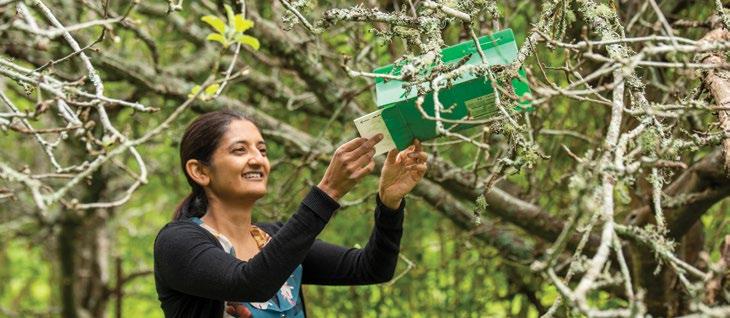
4 minute read
Asha’s career – insects won out over birds
ASHA’S CAREER – INSECTS
WON OUT OVER BIRDS
Elaine Fisher Photos supplied by Plant & Food Research
Asha Chhagan, Plant & Food Research entomologist, is researching the guava moth
Asha Chhagan was so intrigued by biology that when it came to deciding what to specialise in for her master’s degree, she couldn’t decide between birds or insects.
“I was at a fork in the road and could have gone either way. What took me to entomology was when I visited HortResearch (now Plant & Food Research) to meet with a potential supervisor and entomologist Philippa Stevens. She was so passionate about her work that it steered me to entomology,“ says Asha who is now a Plant & Food Research entomologist, based at Mount Albert in Auckland and a member of Women in Horticulture.

Asha is researching the sustainable management, biology and distribution of guava moth which has been in New Zealand for more than 20 years and thrives in the warm Northland climate. Although very much “a city kid,“ Asha says growing food is in her genes. “My parents owned a fruit shop in central Auckland and from a young age I was exposed to lots of exotic fruit and vegetables.“ Among her happy childhood memories is visiting the Turners & Growers auction rooms near the waterfront with her dad early in the morning to pick up fruit and vegetables for the store. “My extended family were market gardeners at Pukekohe, growing potatoes, onions and greens and my relatives in India were market gardeners too, so I guess horticulture is in my blood.“ Asha credits her understanding of the horticultural industry through all stages from growing, to retail to the consumer to her childhood experiences and family traditions. It’s that background which also motivates her to carry out research to make positive differences for growers.

Male guava moths caught in a pheromone trap at Plant & Food Research’s Mount Albert orchard
Her first introduction to that kind of research was working part-time at HortResearch while studying for her master’s project. “Once I graduated, I was lucky enough to be offered a job as a technician which led to opportunities to move through the ranks to researcher and most recently, scientist.“ Despite its name, the guava moth (Coscinoptycha improbana) doesn’t affect only guava fruit. “It has a large host range including feijoa, macadamia, citrus, loquat and plums so is a problem not just for commercial growers but the home gardener too. “I’ve been working on this project for three years and the moth is one of the most challenging of pests when it comes to understanding its life cycle and biology. It doesn’t appear to have a diapause stage (a period of suspended development) but develops throughout the year, using different hosts.“ The female lays its eggs on the surface of fruit and within 24 hours of hatching, the larvae burrow inside and start eating. Once mature, they crawl out, drop to the ground on silken threads, and make a cocoon out of soil and debris. Adult moths emerge, find each other using pheromones, and mate. The whole cycle takes around eight weeks in summer. As the moth is only a pest in New Zealand, the research of Asha and her team is world-leading. Guava moth is native to Australia, quite a different biological and climatic environment. Currently in New Zealand the insect is found in Northland, Auckland, the Coromandel and north Waikato but with climate change Asha believes it will move further south. Management options include pheromone traps for males, mating disruption, insecticides and good orchard hygiene practices including removing fallen fruit and debris from around trees.
While male pheromone traps are an effective tool for monitoring the pest, the ideal solution would be to disrupt mating or create effective traps to capture females. “If we could find attractants for females it would be a big deal because we could shut down the lifecycle and stop eggs being laid and subsequent larval damage in fruit. “Work to collect volatile smells from feijoa and test these attractants in the lab produced some positive results. Unfortunately when we took the experimental attractants into the field we did not catch as many females as we hoped.“ Funding for the research is coming to an end but Asha hopes more can be found. “Now we have got this far, we don’t want to let the research end.“

Asha is a strong advocate for young women considering science as a career. “What I especially love is that my work is really diverse and no day is the same. Science offers so many amazing opportunities for women. I really recommend it, in whatever field, as a career choice.“
To keep up-to-date with Women in Horticulture, its news and activities, and join the membership database, email info@women-in-hort.nz Everyone is welcome.
WeedSeeker 2
Reduce herbicide use by up to 90% Smaller – Lighter – Faster – Smarter
0800 482 682 | www.vantage-nz.com










